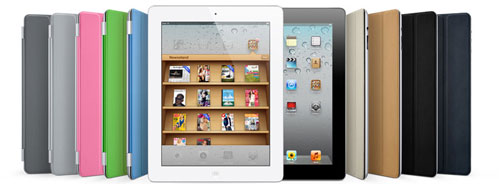
I pad
The iPad is a line of tablet computers designed, developed and marketed by Apple Inc., primarily as a platform for audio-visual media including books, periodicals, movies, music, games, and web content. The iPad was introduced on January 27, 2010 by Apple's then-CEO Steve Jobs. Its size and weight fall between those of contemporary smartphones and laptop computers. The iPad runs the same operating systemas the iPod Touch and iPhone and can run its own applications as well as iPhone applications. Without modification, the iPad will only run programs approved by Apple and distributed via the Apple App Store (with the exception of programs that run inside the iPad's web browser).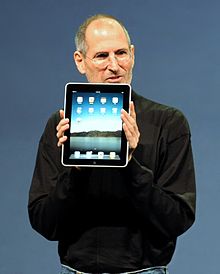
Like iPhone and iPod Touch, the iPad is controlled by a multitouch display—a departure from most previous tablet computers, which used a pressure-triggered stylus—as well as a virtual onscreen keyboard in lieu of a physical keyboard. The iPad uses a Wi-Fi connection to access local area networks and the Internet. Some models also have a 3G wireless network interface which can connect to HSPA or EV-DO data networks to access the Internet. Since the release of iOS 5, the device does not need to be managed and synced by iTunes running on a personal computer viaUSB cable.
Apple released the first iPad in April 2010, and sold 3 million of the devices in 80 days. During 2010, Apple sold 14.8 million iPads worldwide, representing 75% of tablet PC sales at the end of 2010. By the release of the iPad 2 in March 2011, more than 15 million iPads had been sold—selling more than all other tablet PCs combined since the iPad's release. In 2011, it is expected to take 83% of the tablet computing market share in the United States. During the fourth quarter of 2011, Apple sold 15.4 million iPads, in addition to 37 million iPhones and over 5 million Mac computers. Apple sold 300,000 iPads on the day they first became available.Apple announced that it had sold more than 15 million iPads over the course of nine months, generating $9.5 billion in revenue and capturing more than 90% market share in the tablet computer segment.
History Ipad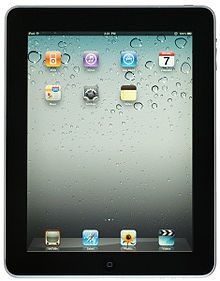
Before the iPad's launch
Apple's first tablet computer was the Newton MessagePad 100, introduced in 1993, which led to the creation of the ARM6 processor core withAcorn Computers. Apple also developed a prototype PowerBook Duo-based tablet, the PenLite, but decided not to sell it in order to avoid hurting MessagePad sales. Apple released several more Newton-based PDAs; the final one, the MessagePad 2100, was discontinued in 1998.
Apple re-entered the mobile-computing markets in 2007 with the iPhone. Smaller than the iPad but featuring a camera and mobile phone, it pioneered the multitouch finger-sensitive touchscreen interface of Apple's iOS mobile operating system. By late 2009, the iPad's release had been rumored for several years. Such speculation mostly talked about "Apple's tablet"; specific names included iTablet and iSlate. The actual name is reportedly a homage to the Star Trek PADD, a fictional device very similar in appearance to the iPad. The iPad was announced on January 27, 2010, by Steve Jobs at an Apple press conference at the Yerba Buena Center for the Arts in San Francisco.
Jobs later said that Apple began developing the iPad before the iPhone, but temporarily shelved the effort upon realizing that its ideas would work just as well in a mobile phone. The iPad's internal codename was K48, which was revealed in the court case surrounding leaking of iPad information before launch.
First generation
Apple began taking pre-orders for the iPad from U.S. customers on March 12, 2010. The only major change to the device between its announcement and being available to pre-order was the change of the behavior of the side switch from sound muting to that of a screen rotation lock. The Wi-Fi version of the iPad went on sale in the United States on April 3, 2010. The Wi-Fi + 3G version was released on April 30. 3G service in the United States is provided by AT&T and was initially sold with two prepaid contract-free data plan options: one for unlimited data and the other for 250 MB per month at half the price. On June 2, 2010, AT&T announced that effective June 7 the unlimited plan would be replaced for new customers with a 2 GB plan at slightly lower cost; existing customers would have the option to keep the unlimited plan. The plans are activated on the iPad itself and can be canceled at any time. 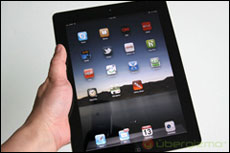
The iPad was initially only available online at The Apple Store as well as the company's retail locations. The iPad has since been available for purchase through many retailers including Amazon, Wal-Mart, Best Buy, Verizon, and AT&T. The iPad was launched in Australia, Canada, France, Germany, Italy, Japan, Spain, Switzerland and the United Kingdom on May 28. Online pre-orders in those countries began on May 10. Apple released the iPad in Austria, Belgium, Hong Kong, Ireland, Luxembourg, Mexico, The Netherlands, New Zealand and Singapore on July 23, 2010. Israel briefly prohibited importation of the iPad because of concerns that its Wi-Fi might interfere with other devices. On September 17, 2010, the iPad was officially launched in China.
300,000 iPads were sold on their first day of availability. By May 3, 2010, Apple had sold a million iPads, this was in half the time it took Apple to sell the same number of original iPhones.During the October 18, 2010, Financial Conference Call, Steve Jobs announced that Apple had sold more iPads than Macs for the Fiscal Quarter. In total, Apple sold more than 15 million first generation iPads prior to the launch of the iPad 2.
iPad 2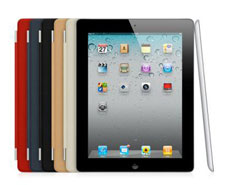
Apple's CEO Steve Jobs unveiled the iPad 2, the second generation of the device, at a March 2, 2011, press conference, despite being on medical leave at the time. About 33% thinner than its predecessor and 15% lighter, the iPad 2 has a better processor, a dual core Apple A5 that Apple says is twice as fast as its predecessor for CPU operations and up to nine times as fast for GPU operations. The iPad 2 includes front and back cameras that support theFaceTime video calling application, as well as a three-axis gyroscope. It retains the original's 10-hour battery life and has a similar pricing scheme.
The iPad 2 has been available for purchase, depending on stock availability, since March 11, 2011, at Apple retail stores in the United States, as well as to American customers shopping online at Apple's retail website. The iPad 2 was released internationally in 25 other countries on March 25, 2011, including Australia, Canada, France, Germany, Mexico and the United Kingdom, but not Japan as originally scheduled due to the earthquake and tsunami.
Screen and input
The iPad's touchscreen display is a 1024 × 768 pixel, 7.75×5.82 in (197×148 mm) liquid crystal display (diagonal 9.7 in (246.4 mm)), with fingerprint- and scratch-resistant glass. Steve Jobs backed the choice of screen size, saying a 7-inch screen would be "too small to express the software" and that 10 inches was the minimum for a tablet screen. Like the iPhone, the iPad is designed to be controlled by bare fingers; normal, non-conductive gloves and styli do not work, although there are special gloves and capacitive styli designed for this use. 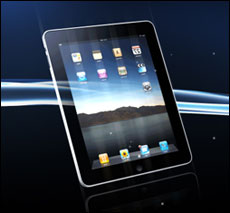
The display responds to other sensors: an ambient light sensor to adjust screen brightness and a 3-axis accelerometer to sense iPad orientation and switch between portrait and landscape modes. Unlike the iPhone and iPod Touch's built-in applications, which work in three orientations (portrait, landscape-left and landscape-right), the iPad's built-in applications support screen rotation in all four orientations, including upside-down. Consequently, the device has no intrinsic "native" orientation; only the relative position of the home button changes.
There are four physical switches on the iPad, including a home button near the display that returns the user to the main menu, and three plastic physical switches on the sides: wake/sleep and volume up/down, plus a software-controlled switch whose function has changed with software updates. Originally the switch locked the screen to its current orientation, but the iOS 4.2 changed it to a mute switch, with rotation lock now available in an onscreen menu. In the iOS 4.3 update, released with the iPad 2, a setting was added to allow the user to specify whether the side switch was used for rotation lock or mute.
The original iPad had no camera; the iPad 2 has a front VGA camera and a rear-facing 720p camera, both capable of still images and 30fps video. The rear-facing camera has a 5x digital zoom for still images only. Both shoot photo and video in a 4:3 fullscreen aspect ratio, unlike the iPhone 4, which shoots in a 16:9 widescreen aspect ratio. Unlike the iPhone, the iPad does not support tap to focus, but does allow you to tap to auto exposure. The cameras allow FaceTime video messaging with iPhone 4, iPod Touch 4, and Snow Leopard/Lion Macs.
Connectivity.jpg)
The iPad can use Wi-Fi network trilateration from Skyhook Wireless to provide location information to applications such as Google Maps. The 3G model supports A-GPS to allow its position to be calculated with GPS or relative to nearby cellphone towers; it also has a black strip on the back to aid 3G reception. The iPad has a headphone jack and a proprietary Apple dock connector, but noEthernet or USB port. However, the Apple Camera Connection Kit accessory provides two dock connector adapters for importing photos and videos via USB and SD memory cards.
Audio and output
The iPad has two internal mono speakers located on the bottom-right of the unit. In the original iPad, the speakers push sound through two small sealed channels leading to the three audio ports carved into the device, while the iPad 2 has its speakers behind a single grill. A volume switch is on the right side of the unit. A 3.5-mm TRRS connector audio-out jack on the top-left corner of the device provides stereo sound for headphones with or without microphones and/or volume controls. The iPad also contains a microphone that can be used for voice recording.
The built-in Bluetooth 2.1 + EDR interface allows wireless headphones and keyboards to be used with the iPad. However, the iOS does not currently support file transfer via Bluetooth. iPad also features 1024 x 768 VGA video output for limited applications, screen capture, connecting an external display or television through an accessory adapter.
Power and battery
The iPad uses an internal rechargeable lithium-ion polymer (LiPo) battery. The batteries are made in Taiwan by Simplo Technology (60%) and Dynapack International Technology. The iPad is designed to be charged with a high current of 2 amperes using the included 10 W USB power adapter and USB cord with a USB connector at one end and a 30-pin dock connector at the other end. While it can be charged by a standard USB port from a computer, these are limited to 500 milliamperes (0.5 amps). As a result, if the iPad is running while powered by a normal USB computer port, it may charge very slowly, or not at all. High-power USB ports found in newer Apple computers and accessories provide full charging capabilities. 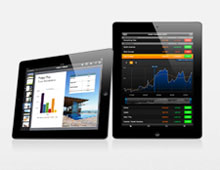
Apple claims that the battery for both generations of iPad can provide up to 10 hours of video, 140 hours of audio playback, or one month on standby. Like any rechargeable battery technology, the iPad's battery loses capacity over time, but is not designed to be user-replaceable. In a program similar to the battery-replacement program for the iPod and the original iPhone, Apple will replace an iPad that does not hold an electrical charge with a refurbished iPad for a fee of US$99 plus $6.95 shipping. As a different unit is supplied, user data is not preserved. The refurbished unit will have a new case. The warranty on the refurbished unit may vary between jurisdictions.
Independent companies also provide a battery replacement service, returning the original unit with new battery but original case. Alternatively it is possible for a technically competent user to buy and install a new battery, which may invalidate any remaining warranty on the iPad. The task does not require soldering, but is technically challenging.
Storage and SIM
The iPad was released with three capacity options for storage: 16, 32, or 64 GB of internal flash memory. All data is stored on the internal flash memory, with no option to expand storage. Apple sells a "camera connection kit" with an SD card reader, but it can only be used to transfer photos and videos.
The side of the Wi-Fi + 3G model has a micro-SIM slot (not mini-SIM). The 3G iPad can be used with any compatible GSM carrier, unlike the iPhone, which is usually sold 'locked' to specific carriers. In the U.S., data network access via T-Mobile's network is limited to slower EDGE cellular speeds because T-Mobile's 3G Network uses different frequencies. The iPad 2 introduced a third tier of models with CDMA support for Verizon Wireless in the United States, available separately from the AT&T capable version.
Optional accessories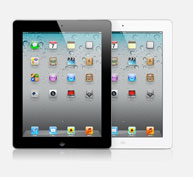
Apple offers several iPad accessories, most of which are adapters for the proprietary 30-pin dock connector, the iPad's only port besides the headphone jack. A dock holds the iPad upright at an angle, and has a dock connector and audio line out port. Each generation of iPad requires a corresponding dock. A dock that included a physical keyboard is available only for the original iPad, but both generations are compatible with Bluetooth keyboards that also work with Macs and PCs. The iPad can be charged by a standalone power adapter ("wall charger") also used for iPods and iPhones, and a 10 W charger is included with the iPad.
Apple sells a camera connection kit that consists of two separate adapters for the dock connector, one to USB Type A, the other an SD card reader. Adapter can be used to transfer photos and videos and to plug USB audio card or MIDI keyboard. A third party sells an adapter that includes USB, SD, andmicroSD on a single unit. An adapter to VGA connectors allows the iPad to work with external monitors and projectors. Another adapter mirrors the screen onto HDMI compatible devices in 1080p and works with all apps and rotations. Unlike other adapters, it allows the iPad to charge through another dock connector. While the HDMI adapter was released with and advertised for the iPad 2, it also works with the first generation iPad, the iPhone 4, and the fourth generation iPod Touch.
Smart Covers are screen protectors that magnetically attach and align to the face of the iPad 2. The cover has three folds which allow it to convert into a stand, which is also held together by magnets. While original iPad owners could purchase a black case that included a similarly folding cover, the Smart Cover is meant to be more minimal, easily detachable, and protects only the screen. Smart Covers have a microfiber bottom that cleans the front of the iPad, which wakes up when the cover is removed. There are five different colors of both polyurethane and leather, with leather being more expensive. Smart Covers are not compatible with the original iPad.
Manufacture 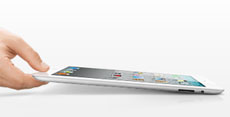
The iPad is assembled by Foxconn, which also manufactures Apple's iPod, iPhone and Mac Mini, in its largest plant in Shenzhen, China. In April 2011, Foxconn announced that it would be moving production of the iPad and other Apple products to Brazil where it could begin production before the end of 2011.
iSuppli estimated that each first-generation iPad 16 GB Wi-Fi version costs US$259.60 to manufacture, a total that excludes research, development, licensing, royalty and patent costs. Apple does not disclose the makers of iPad components, but teardown reports and analysis from industry insiders indicate that various parts and their suppliers include:
-
Apple A4 SoC: Samsung
-
NAND flash RAM chips: Toshiba and Samsung (64 GB model)
-
Touch-screen chips: Broadcom
-
IPS Display: LG Display
-
Touch panels: Wintek (after TPK Touch Solutions was unable to fulfill its orders, delaying the iPad's release from late March to early April)
-
Case: Catcher Technologies
-
LCD drivers: Novatek Microelectronics
-
Batteries: 60% are made in Taiwan by Simplo Technology, 40% by Dynapack International
-
Accelerometer: STMicroelectronics
Software
Like the iPhone, with which it shares a development environment (iPhone SDK, or software development kit, version 3.2 onwards), the iPad only runs its own software, software downloaded from Apple's App Store, and software written by developers who have paid for a developer's license on registered devices. The iPad runs almost all third-party iPhone applications, displaying them at iPhone size or enlarging them to fill the iPad's screen. Developers may also create or modify apps to take advantage of the iPad's features. Application developers use iPhone SDK for developing applications for iPad. The iPad has been shipping with a customized iPad-only version of iPhone OS, dubbed v3.2. On September 1, it was announced the iPad would get iOS 4.2 by November 2010; to fulfil this Apple released iOS 4.2.1 to the public on November 22.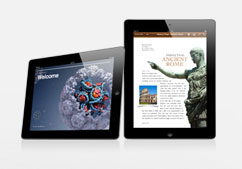
Applications
The iPad comes with several applications, including Safari, Mail, Photos, Video, YouTube, iPod, iTunes, App Store, iBooks, Maps, Notes, Calendar, and Contacts. Several are improved versions of applications developed for the iPhone or Mac.
The iPad syncs with iTunes on a Mac or Windows PC. Apple ported its iWork suite from the Mac to the iPad, and sells pared down versions of Pages, Numbers, and Keynote apps in the App Store. Although the iPad is not designed to replace a mobile phone, a user can use a wired heador the built-in speaker and microphone and place phone calls over Wi-Fi or 3G using a VoIPapplication. As of June, 2011, there were about 90,000 iPad specific apps on the App Store. The iPad cannot run the Xcode development suite since it uses iOS.
In December 2010, Reuters reported that iPhone and iPad users have lodged a lawsuit against Apple alleging that some applications were passing their information to third party advertisers without consent.
Digital rights management
The iPad employs Digital Rights Management to prevent users from copying or transferring certain content outside of Apple's platform without authorization, such as TV shows, movies, and apps . Also, the iPad's development model requires anyone creating an app for the iPad to sign a non-disclosure agreement and pay for a developer subscription. Critics argue Apple's centralized app approval process and control of the platform itself could stifle software innovation. Of particular concern to digital rights advocates is Apple's ability to remotely disable or delete apps, media, or data on any iPad at any time.
Digital rights advocates, including the Free Software Foundation, Electronic Frontier Foundation, and computer engineer and activist Brewster Kahle, have criticized the iPad for its digital rights restrictions. In April 2010, Paul Sweeting, an analyst with GigaOM, was quoted by National Public Radio as saying, "With the iPad, you have the anti-Internet in your hands. ... It offers [the major media companies] the opportunity to essentially re-create the old business model, wherein they are pushing content to you on their terms rather than you going out and finding content, or a search engine discovering content for you." But Sweeting also thought that the limitations imposed by Apple impart the feeling of a safe neighborhood, saying, "Apple is offering you a gated community where there's a guard at the gate, and there's probably maid service, too." Laura Sydell, the article's author, concludes, "As more consumers have fears about security on the Internet, viruses and malware, they may be happy to opt for Apple's gated community."
Jailbreaking 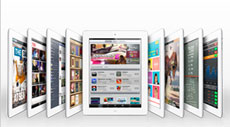
Like other iOS devices, the iPad can be "jailbroken", allowing applications and programs that are not authorized by Apple to run on the device. Once jailbroken, iPad users are able to download many applications previously unavailable through the App Store via unofficial installers such as Cydia, as well as illegally pirated applications. Apple claims jailbreaking voids the factory warranty on the device in the United States even though jailbreaking is legal. The iPad, released in April 2010, was first jailbroken in May 2010 with the Spirit jailbreak for iOS version 3.1.2. The iPad can be jailbroken on iOS versions 4.3 through 4.3.3 with the web-based tool JailbreakMe 3.0 (released in July 2011), and on iOS versions including 5.0 and 5.0.1 using redsn0w.
Censorship
Apple's App Store, which provides iPhone and iPad applications, imposes censorship of content, which has become an issue for book publishers and magazines seeking to use the platform. The Guardian newspaper described the role of Apple as analogous to that of British magazine distributor WH Smith, which for many years imposed content restrictions.
Due to the exclusion of pornography from the App Store, YouPorn and others changed their video format from Flash to H.264 and HTML5 specifically for the iPad. In an e-mail exchange with Ryan Tate from Valleywag, Steve Jobs claimed that the iPad offers "freedom from porn", leading to many upreplies including Adbustings in Berlin by artist Johannes P. Osterhoff and in San Francisco during WWDC10.
Books, news, and magazine content
The iPad has an optional iBooks application that can be downloaded from the App Store, which displays books and other ePub-format content downloaded from the iBookstore. For the iPad launch on April 3, 2010, the iBookstore is available only in the United States. Several major book publishers including Penguin Books, HarperCollins, Simon & Schuster and Macmillan have committed to publishing books for the iPad. Despite being a direct competitor to both the Amazon Kindle and Barnes & Noble Nook, both Amazon.com and Barnes & Noble have made Kindle & Nook apps available for the iPad.
In February 2010, Condé Nast said it would sell iPad subscriptions for several of its magazines by June.
In April 2010, the New York Times announced that it would begin publishing daily on the iPad. The "Top News" section is available free of charge, and the remainder on payment of a subscription. Major news organizations, including the Wall Street Journal, the BBC, and Reuters have released iPad applications, to varying degrees of success. NewsCorp created an iPad-only publication, The Daily, in February 2011.
Reception 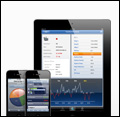
On May 28, 2010, the iPad was released in Australia, Canada, and Japan, as well as in several larger European countries. Media reaction to the launch was mixed. The media noted the positive response from fans of the device, with thousands of people queued on the first day of sale in a number of these countries.
Reaction to the announcement
Media reaction to the iPad announcement was mixed. Walt Mossberg wrote, "It's about the software, stupid", meaning hardware features and build are less important to the iPad's success than software and user interface, his first impressions of which were largely positive. Mossberg also called the price "modest" for a device of its capabilities, and praised the ten-hour battery life. Others, including PC Advisor and the Sydney Morning Herald, wrote that the iPad would also compete with proliferating netbooks, most of which use Microsoft Windows. The base model's $499 price was lower than pre-release estimates by the tech press, Wall Street analysts, and Apple's competitors, all of whom were expecting a much higher entry price point.
CNET also criticized the iPad for its apparent lack of wireless sync which other portable devices such as Microsoft's Zune have had for a number of years. The built-in iTunes app is able to download from the Internet as well.
Reviews
Reviews of the iPad have been generally favorable. Walt Mossberg of The Wall Street Journal called it a "pretty close" laptop killer. David Pogue of The New York Times wrote a "dual" review, one part for technology-minded people, and the other part for non-technology-minded people. In the former section, he notes that a laptop offers more features for a cheaper price than the iPad. In his review for the latter audience, however, he claims that if his readers like the concept of the device and can understand what its intended uses are, then they will enjoy using the device. PC Magazine's Tim Gideon wrote, "you have yourself a winner" that "will undoubtedly be a driving force in shaping the emerging tablet landscape. Michael Arrington of TechCrunch said, "the iPad beats even my most optimistic expectations. This is a new category of device. But it also will replace laptops for many people." PC World criticized the iPad's file sharing and printing abilities, and ArsTechnica said sharing files with a computer is "one of our least favorite parts of the iPad experience."
The media also praised the quantity of applications, as well as the bookstore and other media applications. In contrast they criticized the iPad for being a closed system and mentioned that the iPad faces competition from Android based tablets. However, the Android tablet OS, known as Honeycomb, is not open source and has fewer apps available for it than for the iPad. The Independent criticized the iPad for not being as readable in bright light as paper but praised it for being able to store large quantities of books. After its UK release the Daily Telegraph said the iPad's lack of Adobe Flash support was "annoying."
Recognition
The iPad was selected by Time Magazine as one of the 50 Best Inventions of the Year 2010, while Popular Science chose it as the top gadget behind the overall "Best of What's New 2010" winner Groasis Waterboxx.
Usage Iphone
Business 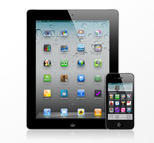
While the iPad is mostly used by consumers it also has been taken up by business users. Within 90 days of its release, the iPad managed to penetrate 50% of Fortune 100 companies. Some companies are adopting iPads in their business offices by distributing or making available the iPads to employees. Examples of uses in the workplace include attorneys responding to clients, medical professionals accessing health records during patient exams, and managers approving employee requests.
A survey by Frost & Sullivan shows that iPad usage in office workplaces is linked to the goals of increased employee productivity, reduced paperwork, and increased revenue. The research firm estimates that "The mobile-office application market in North America may reach $6.85 billion in 2015, up from an estimated $1.76 billion [in 2010]."
Since March 2011, the US Federal Aviation Administration has approved the iPad for in-cockpit use to cut down on the paper consumption in several airlines. In 2011, Alaska Airlines became the first airline to replace pilots' paper manuals with iPads, weighing 0.68 kg compared to 11 kg for the printed flight manuals. It hopes to have fewer back and muscle injuries. More than a dozen airlines have followed suit, including United, which has distributed 11,000 iPads to cockpits. Also, many airlines now offer their inflight magazine as a downloadable application for the iPad.
Education and healthcare
The iPad has several uses in the classroom, and has been praised as a valuable tool for homeschooling. Soon after the iPad was released, it was reported that 81% of the top book apps were for children. The iPad has also been called a revolutionary tool to help children with autism learn how to communicate and socialize more easily. Many colleges and universities have also used the iPad. In 2010, Youngstown State University began offering three-hour rentals for the iPad.
In the healthcare field, iPads and iPhones have been used to help hospitals manage their supply chain. For example, Novation, a healthcare contracting services company, developed VHA PriceLynx (based on the mobile application platform of business intelligence software vendor MicroStrategy), a business intelligence app to help health care organizations manage its purchasing procedures more efficiently and save money for hospitals. Guillermo Ramas of Novation states, "Doctors won't walk around a hospital with a laptop. With an iPad it's perfect to walk around the hospital with as long as they have the information they need."
Consumer usage 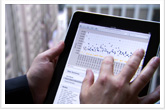
During the 2010 Major League Baseball free agent season, the agent for the player Carl Crawford was sending iPads to prospective teams interested in Mr. Crawford. These iPads were pre-loaded with video clips highlighting his player, and how it would benefit their team to have him.
In the United States fans attending Super Bowl XLV, the first Super Bowl since the iPad was released, could use an official National Football League (NFL) app to navigate Cowboys Stadium. In 2011, the Tampa Bay Buccaneers became the first NFL club to discontinue the use of paper copies of playbooks, and instead distributed all players their playbook and videos in electronic format via aniPad 2.
The iPad is able to support many music creation applications in addition to the iTunes music playback software. These include sound samplers, guitar and voice effects processors, sequencers for synthesized sounds and sampled loops, virtual synthesizers and drum machines, theremin-style and other touch responsive instruments, drum pads and many more. Gorillaz's 2010 album, The Fall, was created almost exclusively using the iPad by Damon Albarn while on tour with the band.
The iPad has introduced a new way of watching television. The second screen expression is a consequence of the media multitasking which is exploding.
source : Wikipedia
Valve | PEX pipe | Push fit system | Plastic pipe | HDPE pipe | Water pipe
UPVC pipe | Spiral pipe | Gas pipe | Underground pipe | Polyethylene pipe fitting | Pipe installation